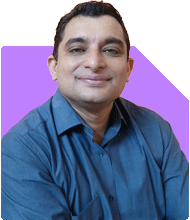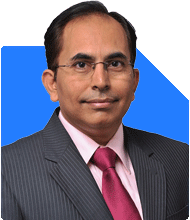Ramalingam Kalirajan |10902 Answers |Ask -Follow
Mutual Funds, Financial Planning Expert - Answered on May 23, 2024
He has an MBA in finance from the University of Madras and is a certified financial planner.
He is the director and chief financial planner at Holistic Investment, a Chennai-based firm that offers financial planning and wealth management advice.... more

I am 24 year old and started working couple of months ago. I earn around 70K/ per month and don't have any loans yet. How do I start investing for retirement?
Starting early gives you a significant advantage through the power of compounding.
Understanding Retirement Planning
Retirement planning is about ensuring you have enough funds to maintain your lifestyle after you stop working.
Starting early helps you build a substantial retirement corpus.
Setting Clear Goals
First, define your retirement goals.
Consider the lifestyle you want and the amount you might need to maintain it.
Assessing Your Financial Situation
You earn ?70,000 per month and have no loans.
This is a good position to start investing.
Creating a Budget
Create a budget to manage your expenses and savings.
Aim to save at least 20-30% of your income for investments.
Emergency Fund
Before investing, build an emergency fund.
This should cover 3-6 months of your living expenses.
Systematic Investment Plan (SIP)
SIP is a disciplined way to invest in mutual funds.
It allows you to invest a fixed amount regularly.
Benefits of SIP
Rupee Cost Averaging: SIPs help average out the purchase cost over time.
Compounding: Regular investments leverage the power of compounding.
Discipline: SIPs ensure you invest regularly without market timing.
Choosing the Right Funds
Equity Mutual Funds: These are suitable for long-term growth and higher returns.
Debt Funds: Include these for stability and lower risk.
Balanced Funds: These combine equity and debt for moderate risk and returns.
Benefits of Actively Managed Funds
Higher Returns: Skilled fund managers aim to outperform the market.
Flexibility: Managers can adjust portfolios based on market conditions.
Diversification: Actively managed funds often have a well-diversified portfolio.
Disadvantages of Index Funds
Limited Flexibility: Index funds track an index strictly, limiting flexibility.
No Outperformance: They aim to match, not outperform, the index.
Market Cap Bias: These funds are heavily weighted towards large-cap stocks.
Disadvantages of Direct Funds
Lack of Guidance: Direct funds lack the expert advice provided by MFDs with CFP credentials.
Holistic Planning: Regular funds ensure a comprehensive financial plan.
Steps to Start Investing
Set Clear Goals: Define your retirement goals and investment horizon.
Risk Assessment: Assess your risk tolerance to choose suitable funds.
Choose Funds: Select a mix of equity, debt, and balanced funds.
KYC Compliance: Complete the mandatory KYC process for mutual fund investments.
Start SIP: Decide the SIP amount and start investing in chosen funds.
Monitoring and Adjusting Your Investments
Regular Review: Periodically review your investment portfolio.
Adjustments: Make necessary adjustments based on performance and goals.
Stay Informed: Keep yourself updated with market trends and news.
Importance of Consulting a Certified Financial Planner
Personalized Advice: A CFP provides tailored investment strategies.
Holistic Planning: They consider your entire financial situation and goals.
Expert Guidance: Benefit from their expertise and market knowledge.
Diversification and Rebalancing
Diversification: Spread your investments across different asset classes.
Rebalancing: Periodically rebalance your portfolio to maintain the desired asset allocation.
Conclusion
Starting your retirement planning now will ensure a secure and comfortable future.
Remember to stay disciplined and review your investments regularly.
Best Regards,
K. Ramalingam, MBA, CFP,
Chief Financial Planner,
www.holisticinvestment.in
You may like to see similar questions and answers below
Ramalingam Kalirajan |10902 Answers |Ask -Follow
Mutual Funds, Financial Planning Expert - Answered on Apr 30, 2024
Jinal Mehta | Answer |Ask -Follow
Financial Planner - Answered on Feb 01, 2024
Ramalingam Kalirajan |10902 Answers |Ask -Follow
Mutual Funds, Financial Planning Expert - Answered on May 23, 2024
Ramalingam Kalirajan |10902 Answers |Ask -Follow
Mutual Funds, Financial Planning Expert - Answered on Nov 04, 2024
Ramalingam Kalirajan |10902 Answers |Ask -Follow
Mutual Funds, Financial Planning Expert - Answered on Jan 20, 2025
Anu Krishna |1749 Answers |Ask -Follow
Relationships Expert, Mind Coach - Answered on Dec 17, 2025
Anu Krishna |1749 Answers |Ask -Follow
Relationships Expert, Mind Coach - Answered on Dec 17, 2025
Radheshyam Zanwar |6748 Answers |Ask -Follow
MHT-CET, IIT-JEE, NEET-UG Expert - Answered on Dec 17, 2025
Anu Krishna |1749 Answers |Ask -Follow
Relationships Expert, Mind Coach - Answered on Dec 17, 2025
Dr Shakeeb Ahmed Khan |184 Answers |Ask -Follow
Physiotherapist - Answered on Dec 17, 2025
T S Khurana |538 Answers |Ask -Follow
Tax Expert - Answered on Dec 17, 2025
T S Khurana |538 Answers |Ask -Follow
Tax Expert - Answered on Dec 17, 2025
Janak Patel |72 Answers |Ask -Follow
MF, PF Expert - Answered on Dec 17, 2025
Ramalingam Kalirajan |10902 Answers |Ask -Follow
Mutual Funds, Financial Planning Expert - Answered on Dec 17, 2025
Samraat Jadhav |2511 Answers |Ask -Follow
Stock Market Expert - Answered on Dec 17, 2025






























